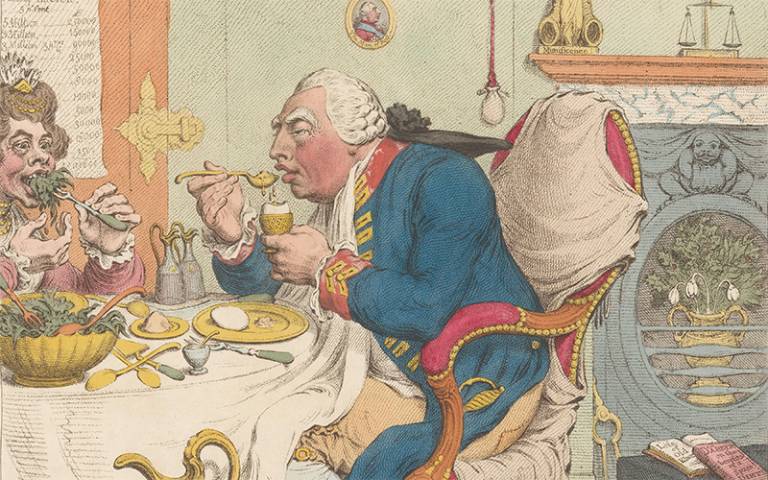Chicken broth & lobster among 3,000 dishes served to King George III
3 November 2023
A list of 3,000 unique dishes served to King George III at Kew Palace and the Prince Regent, George IV at Carlton House between 1788-1813 has been compiled by a team involving a UCL researcher.

Published in Food & History by a team based at UCL, University of Birmingham, Leeds Beckett University and the University of Essex, the result is an in-depth database of food eaten by the two kings, which includes the unique dishes, as well as 40,000 served dishes.
Each dish has been classified by key ingredients and cooking methods resulting in over 1.3 million points of valuable scholarly data, which paints a detailed picture of daily eating in the royal households.
Co-lead author Dr Adam Crymble (UCL Information Studies) said: “By reviewing the kitchen ledgers of Georgian royal palaces, we have uncovered fascinating insights into the eating habits of King George III, his son George IV, and their royal households. Many dishes – such as Turkish kebabs – only appeared once or twice, suggesting that there a lot of experimenting going on in the palace kitchens, including with cuisines imported from abroad.
“Our research also shows how the children in the palaces often ate different meals to the adults, typically less rich and including healthy servings of vegetables, showing that even princes and princesses ate ‘children’s food’.”
Co-author Dr Sarah Fox (University of Birmingham) said: “The data we set out in our study really shows the difference between the eating habits of the King and the Prince Regent. George IV was known for his taste for the finer things in life, including at the dinner table. By comparison, King George III’s love of the simpler rural life is reflected in his eating habits. Dishes featuring eggs, lark and ortolan and out of season vegetables were amongst the most expensive foods eaten by King George III, whereas the Prince Regent feasted on elaborate desserts, a wide range of alcohol and meat-heavy sideboards which were served at every meal.”
Data came from two kitchen ledgers from Kew Palace and Carlton House. These bills of fare contain the daily food allocations of every table in the two palaces between the years 1788-1813, which includes two periods in which George III was seriously suffering from his mental health crises.
The top 10 dishes consumed by the third Georgian king were:
- Chicken broth
- Sweet tarts
- Roasted capon (similar to roast chicken)
- Roast mutton
- Asparagus
- Lobster
- Spinach
- Artichokes
- Roast chicken
- Roast beef
The food in the royal household ledgers also displays the impact of the British Empire on British eating habits. Sugar, spices, chocolate, tea, and coffee all appear in the ledgers reflecting the transformation of the British public’s eating and drinking habits during the eighteenth century. The British love of foreign cuisines can be seen by the appearance of pasta and parmesan, and Turkish kebabs on George III’s dinner table.
Dr Fox added: “George III really enjoyed eating a roast chicken, and a fruit tart or pudding for dessert. Meals like this aren’t all that different to the food we enjoy today.
“This data is invaluable to understanding the different members of the royal households, from the King and Queen, down to their housemaids. It shows us how they lived publicly and privately, how social rank affected the food that you ate, and the way physicians viewed the connection between health and food. More than that though, this information helps us to think about how ingredients, flavours, and cooking methods from Britain and across the globe, came together during a time when British identity was being defined at the dinner table.”
Links
- Research paper published in Food & History
- Dr Adam Crymble’s academic profile
- UCL Information Studies
- UCL Faculty of Arts & Humanities
Image
- King George III, by artist James Gillray in 1792. Source: Rijksmuseum (CC0 1.0 DEED)
Source
Media contact
Chris Lane
tel: +44 20 7679 9222 / +44 (0) 7717 728648
E: chris.lane [at] ucl.ac.uk
 Close
Close

